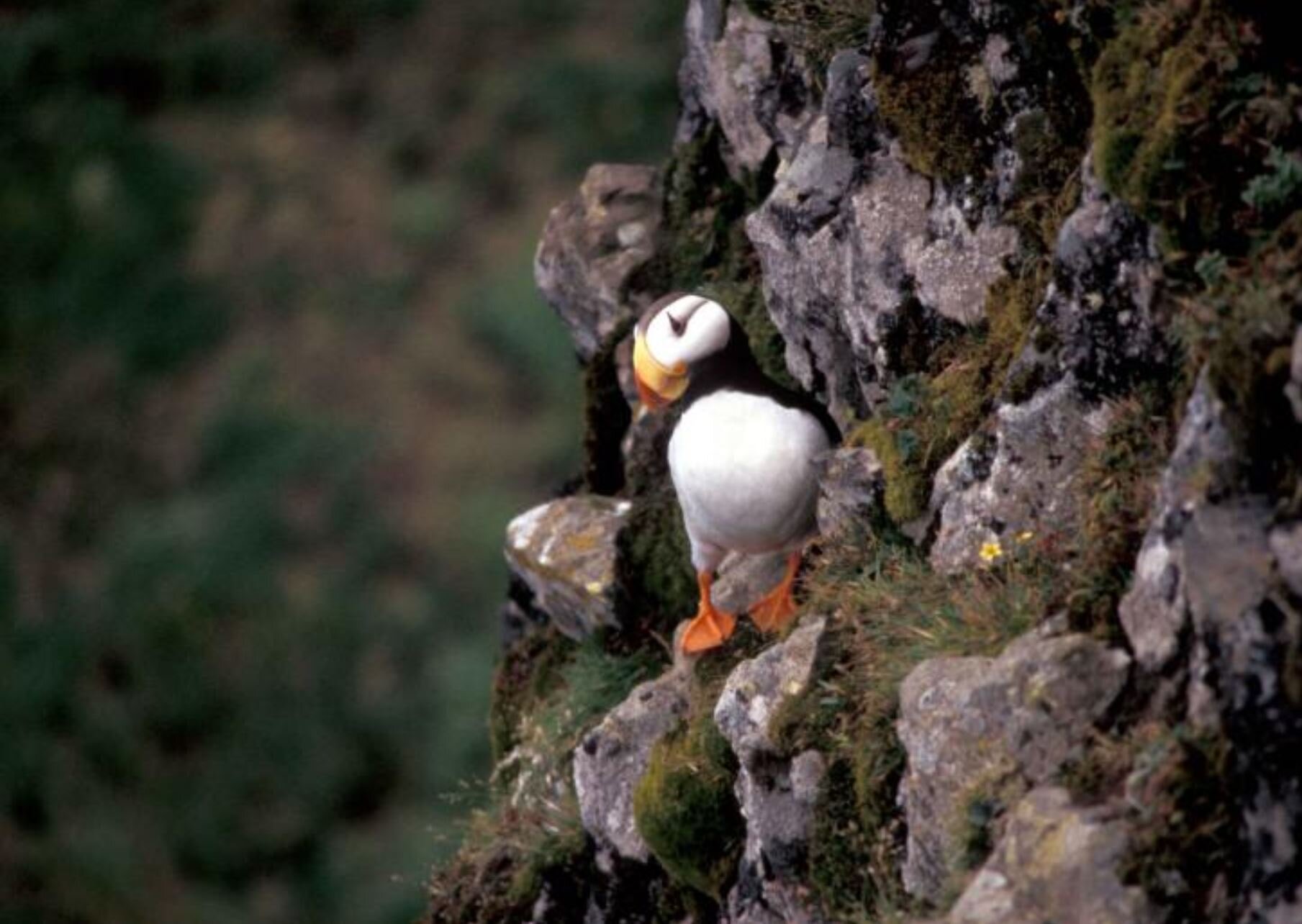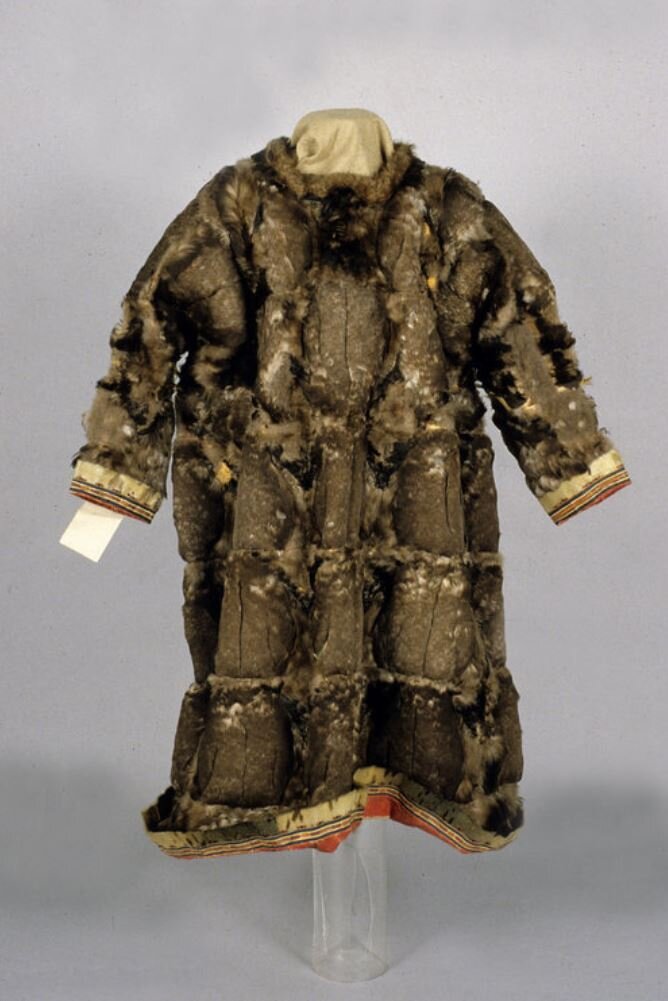Horned Puffin Fact Sheet
By Yumeko Ziegler
The horned puffin is one of the most iconic birds in Alaska. Between tufted and horned puffins, the horned puffin is what we can find all over our stores as souvenirs. Affectionately dubbed Quengacuar(aq) in Scammon Bay, meaning “little nose,” horned puffins have a special place in Alaskan culture.
Horned puffins are seabirds, so they spend most of their time in the open water. However, they can be found in colonies on cliffs and islands, usually on a cliff or crevice, and can be easily identified by their white bellies and their bright orange and yellow bills. They can be found “flying” underwater, using their wings to take them as deep as 250 feet (76.2 m) underwater.
Horned puffins are not threatened or endangered, however they’re facing increasing dangers, including:
Limited food supply due to rising sea temperatures
Marine fishery nets
Complications from eating plastics and microplastics
DID YOU KNOW…
Horned puffins were called “sea parrots” by early sailors
Baby puffins are called “pufflings”
One puffin was observed carrying 65 fish in her bill for her nestlings
Horned puffins bond for life and rub bills as a sign of affection
After breeding season, horned puffins will shed their colorful bills for a smaller and less colorful bill
SCIENTIFIC AND COMMON NAMES
Fratercula corniculata - Horned Puffin, meaning “horned little brother." Also known as Qategarpak in Yupik, meaning “big white breast.”
Photo courtesy of Morkill Anne, USFWS
GENERAL DESCRIPTION
Horned puffins have a large colorful bill, stout bodies, white bellies, short wings, and orange or red webbed feet placed far back on their bodies. Breeding adults have iconic “horns,” which are small fleshy spikes that extend above their eyes. Compared to the breeding adults, immature or non breeding puffins have grey faces and a smaller bill. Adults are about 14 inches (35.56 cm) long and weigh about 1 ¼ pounds (600 gm).
Horned puffins have short wings, making their flight appear awkward, requiring a run on the ground to push themselves aloft. Because take off is difficult for them, horned puffins fly close to the water initially, sometimes beating the water with their wings to propel themselves up.
They compensate for this by being nimble walkers and great swimmers. Horned puffins use their wings to “fly” underwater, using their webbed feet to change directions, generally going 100 feet (30.48 m) deep but are capable of going 250 feet (76.2 m) deep.
RANGE
Map courtesy of The Cornell Lab
Horned puffins are found in the North Pacific Ocean. They spend most of their lives on the open sea, and they only visit land to breed in May or later in northern areas. Normally, horned puffins are relatively close to land, but sometimes their commute is over 60 miles (96.6 km) to reach productive foraging grounds in the Gulf of Alaska and Bering Sea. After nesting season ends, they return to the central North Pacific.
When they are on land, they live on cliff sides and crevices between boulders. They occasionally dig burrows for their eggs like other puffins do, but they’re more well known for nesting on cliffs. Their nests are lined with grass, algae, twigs, and feathers, though some eggs have more than others.
Check out this video of a baby puffin’s first swim!
THREATS/CONCERNS
Although horned puffins aren’t currently listed as endangered or threatened, they are being increasingly affected by climate change. Due to increased sea temperatures, horned puffins’ fish supply is decreasing, which caused many horned puffins to die and wash ashore in Alaska from 2016-2019.
Alongside dwindling food supply, they’re also eating more plastics. From an article from 2019, we know that there are 5.25 trillion pieces of plastic debris in the ocean. So, it is not uncommon for horned puffins to swallow plastic or swim in polluted water. Because puffins live primarily in aquatic habitats, they are especially vulnerable to oil pollution and some undergo a complete molt.
There are some efforts being made to protect puffins in Alaska. Humans sometimes disturb their nests, which may cause a puffin to desert their nest. However, most seabird nesting colonies in Alaska are protected by federal and state laws.
LIFE HISTORY
Horned puffins will start migrating to land in May to mate and lay their eggs, though the more Northern puffins may start later due to the late spring. Horned puffin couples are bonded for life, and can be seen rubbing bills. Horned puffin couples can be found rubbing bills with puffins of the same sex who have adjacent nests.
Horned puffins will lay a single white egg on a cliff side or a crevice between boulders, when both parents will incubate the egg for a total of 42-47 days in July or early August. The egg is a chalky white and may have some light marks on them, and when they hatch the puffling will be covered in down. They are able to walk but will stay in their nests. The pufflings’ parents will bring them fish, held horizontally in their bills like the photo above. 45-55 days later the puffling will be fledged and ready to return to the ocean with their parents. After the breeding season ends, puffins will shed the outer layer of their bills and will have a smaller, less colorful bill for the winter, and their feathers will become gray.
DIET
Horned puffins primarily eat fish. This consists of greenling, capelin, pollock, various salmon species, northern smoothtongue, sandlance, etc. as well as different types of invertebrates like squid, octopus, krill, and bristleworms. Ornithologists believe that horned puffins forage partially at night because they also catch lanternfish, which is a bioluminescent fish. During the breeding season, they catch smaller fish so their pufflings can more easily swallow.
CULTURAL SIGNIFICANCE
Puffins are used for food and clothing by Alaskan Natives. For clothing, Inuit people make parkas out of puffin skins because they are very tough, and they have worn feathers for lining. Their beak plates were collected and strung together to form rattles to be used by shamans in rituals. Aleuts and Inuits sewed those beak plates for decoration on their garments.
Photo courtesy of the Alaska Museum
HORNED PUFFIN COLORING SHEET
We hoped you learned something new about horned puffins! Check out our Facebook, Instagram, or Twitter if you’d like to learn more about Alaska wildlife. Also, subscribe to our free newsletter to learn more about Alaska Wildlife Alliance! To become a member and support wildlife conservation in Alaska with AWA, it’s $35 dollars a year!
_____________________________________________________________________________
Information obtained from: Alaska Native Knowledge Network, Alaska Department of Fish and Game, National Park Service, The Cornell Lab: All About Birds







